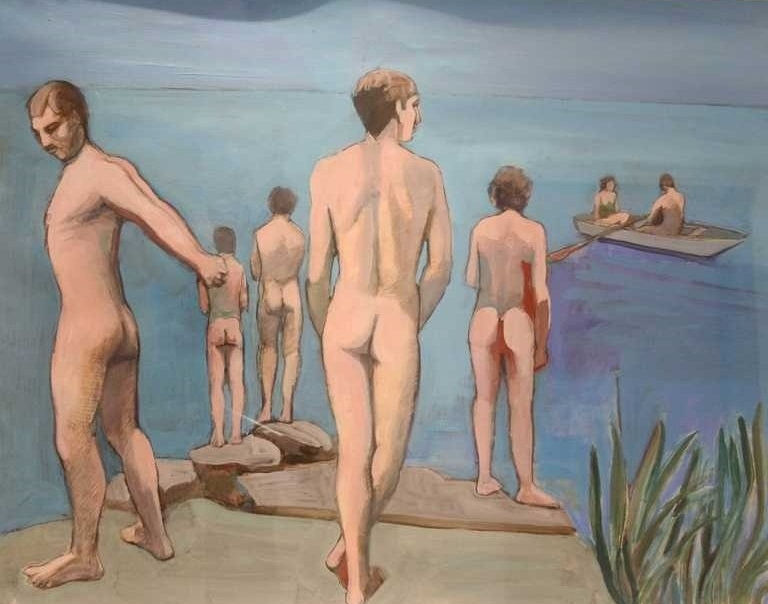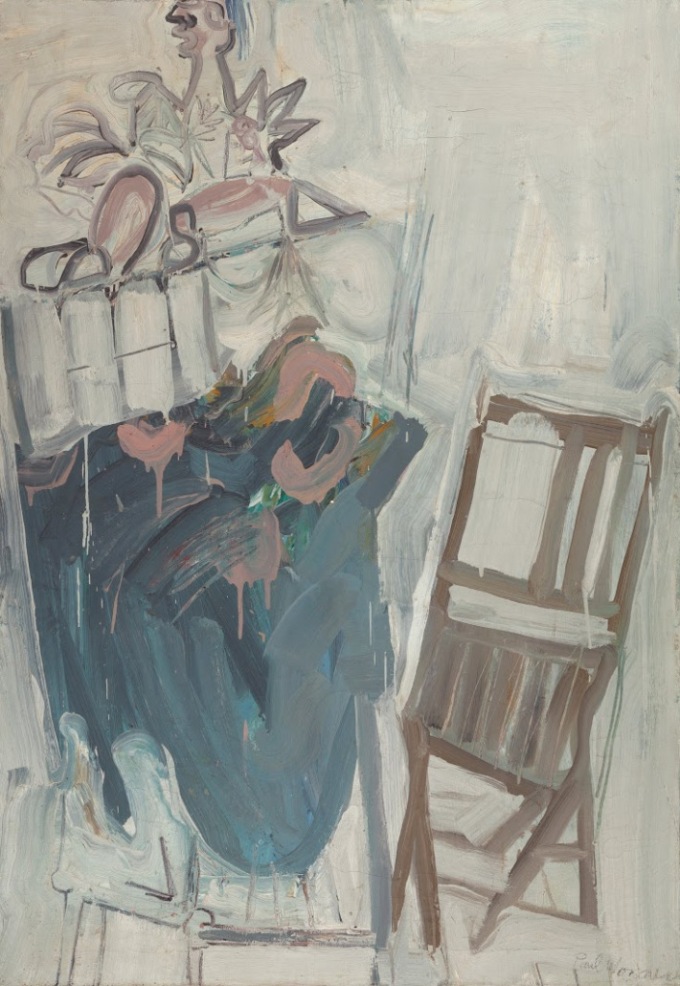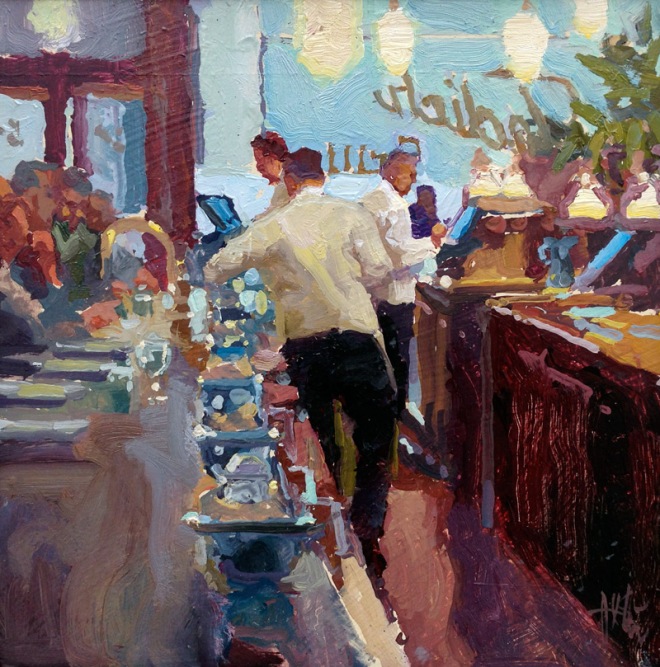The Birth of Bay Area Figuration
June 23, 2023 § 1 Comment

IN 1952, while studying for their master’s degrees in art, Paul Wonner and Theophilus Brown met at the University of California, Berkeley.
After graduating, they found studio space on Berkeley’s Shattuck Avenue, a building they shared with Richard Diebenkorn, David Park and Elmer Bischoff, among others, who met there for drawing sessions. From this creative association came the movement that became known as Bay Area Figuration (or the Bay Area Figurative Movement) in which recognizable subject matter and the gestural bravura of Abstract Expressionism co-existed.
It was the first contemporary artistic movement that achieved recognition in the United States and abroad that originated in California.
REVIEW: “Making the rules“

‘This may be my best painting’
June 6, 2023 § Leave a comment

By MATT GONZALEZ
I first met Paul Wonner and Bill Brown in the early 2000s at the San Francisco home of the gallerist Charles Campbell and his artist wife, Glenna.
I particularly enjoyed watching Bill and Paul look at their own paintings, which hung in the Campbells’ Potrero Hill home. Charlie and Glenna had a wonderful collection, which included their Bay Area Figurative associates, including Richard Diebenkorn, David Park, Joan Brown, Manuel Neri, Elmer Bischoff, Wayne Thiebaud and Nathan Oliveira. There was something about the way that Bill and Paul studied their own paintings that seemed as if they were discovering them for the first time.
Once when I was with Paul and Charlie in the living room, among a Neri plaster and paintings by Frank Auerbach and Thiebaud, Paul was staring intently at one of his own paintings, his 1961 Nude with Indian Rug. I was anticipating his disapproval when he said, “This may be my best painting.” Charlie was so excited that he went over to the kitchen, asked Glenna and Bill to join us, and made Paul repeat the remark. Whether the wine had already gotten to him, I do not know, as Paul made too many fine paintings in my estimation to call any one of them his best. However, there was in his comment an excitement about engaging with a work from another era. We all enjoyed a hearty toast to the sentiment.
— excerpted from Breaking the Rules: Paul Wonner and Theophilius Brown, a catalog for the exhibition of the same title at the Crocker Art Museum in Sacramento, which continues through August 27.
‘Probably a six-pack’
December 14, 2021 § Leave a comment

ONE DAY IN THE mid-90s, not long after I opened my gallery, in the door one afternoon walked the great sculptor Manuel Neri — quite a thrill for a new gallery owner interested in California art.
“Is this where my old roommate Hank Villierme is showing?” he asked.
We’d recently opened a major exhibition of Henry Villierme’s paintings, his first in ages. Villierme had been a rising star, one of a dozen artists included in the seminal 1957 Bay Area figurative exhibition at the Oakland Museum, before he disappeared from the art scene and went to work for a living. Villierme and Neri were roommates while they both attended what was then the California College of Arts and Crafts, a major site of artistic ferment in that era.
I was too star-struck to remember much of the conversation with Neri. But later I showed Villierme a picture I’d run across of him and Neri back when they were roommates. Henry took a look and smiled. “Probably a six-pack under my arm,” he said.
— Thomas Reynolds
MORE: “Neri first exhibited on Fillmore“
Popping up again
May 3, 2019 § 2 Comments
Q & A | PAMELA FEINSILBER
For two decades he ran the Thomas Reynolds Gallery, an elegant, welcoming art gallery just off Fillmore Street. Since 2015, Thomas Reynolds has exhibited art online and privately by appointment. When a jewel of a space at 1906 Fillmore became available a couple of years ago, he organized a pop-up exhibition. And now, until the end of June, he’s showing art there again.
We met when you were my boss as editor and publisher of California Lawyer magazine. The next thing I knew, you had an art gallery. How did that happen?
I got interested in art and design as a young lawyer in Chicago, going to the Art Institute on Thursday nights. When I came to California Lawyer, we always aimed for strong covers — we even had a Gauguin on the cover once when we wrote about litigation over the bequest that created the Armand Hammer Museum in L.A. I think you edited that story. Through the magazine, I met some wonderful, just-emerging contemporary California painters. Francis Livingston and James Stagg both painted early covers of California Lawyer, and both were in my first gallery show, in 1994.
What made you decide to open a gallery?
I happened into the graduate exhibition of a young painter who lived near Fillmore, Veerakeat Tongpaiboon. His family owned Neecha, the Thai restaurant then at Sutter and Steiner, and many of his paintings were of this area. I lived here, too, and had already fallen in love with the neighborhood. On a lark, I rented the three-room Victorian space at 2291 Pine Street to show Veerakeat’s paintings, and those of a few other artists I admired. I had a six-week lease — it was to be one exhibition, not a new venture.
What happened?
I loved it — both being surrounded by art and becoming more involved in the neighborhood. And people loved Veerakeat’s paintings. His first three shows sold out and he was able to buy a home nearby, where he still lives and paints. I found a lot of satisfaction in helping launch the careers of some incredibly talented painters who’ve had great success.
Wonner-Brown estate to the Crocker
March 30, 2019 § Leave a comment

William Theophilus Brown | Standing Bathers (1993)
THE CROCKER ART MUSEUM in Sacramento has received more than 1,800 works of art by Paul Wonner and William Theophilus “Bill” Brown and established the Paul Wonner and William Theophilus Brown Endowment Fund.
In accordance with the artists’ wishes, the fund will support museum projects relating to emerging artists or lesbian, gay, bisexual, transgender, queer, or questioning and intersex artists.
By 2023, the Crocker Art Museum will use the fund to mount an exhibition of the work of Wonner and Brown — the most comprehensive show of the artists’ body of work ever presented — and produce an accompanying catalogue.
“Paul Wonner and Bill Brown were trail blazers, both individually and as a couple,” said the museum’s associate director and chief curator, Scott A. Shields. “It is wonderful that their legacy will live on, not only through their own art, but though their forward-looking support of other artists. It is what they wanted, and everyone at the Crocker is honored to be able to realize their vision.”
Read more from the Crocker Museum
Artists and influences
April 24, 2017 § Leave a comment
BAY AREA ARTISTS Kim Frohsin and Sandy Ostrau discuss the Matisse/Diebenkorn exhibition, the Bay Area Figurative Movement and other influences on their work, in conversation with the Smithsonian Institution’s Paul Karlstrom.
In the studio with Kim Frohsin
February 19, 2017 § Leave a comment
Q & A | KIM FROHSIN
What is the creative process like for you?
To date it’s one in which one series or interest will somehow, in a deeply intuitive and subliminal way, lead naturally into the next work. To me, it seems like an innate flow and natural transition typifies my modus operandi over the last 29 years. There have certainly been times when my art is directly influenced by life circumstances or my reaction to those circumstances. Life on a personally intimate scale or on a large scale — for example, the death of my dog, or my reaction to 9/11. The art can serve sometimes as documentation, therapy or an emotional necessity for self-expression; the art simply emerges, life translated into imagery.
Paul Wonner and the ‘Femme au Coq’
November 6, 2016 § Leave a comment

Paul Wonner | Still Life with “Femme au Coq”
By MATT GONZALEZ
For several years in the early 1950s, Paul Wonner returned to a subject matter in his art making practice: the painting of a still life with femme au coq, translated from the French as woman with rooster. Anyone familiar with modern European painting would recognize the motif as it was explored by many artists, including Pablo Picasso and Marc Chagall. The trope presents the rooster as a symbol of sexuality, virility and fertility. Paired with the woman, it exalts romantic love and the heterosexual coupling traditionally associated with marriage.
It is curious that Wonner would find the subject matter interesting enough to return to it over the years — at least four known times in a four- to five-year period — while he was a student at U.C. Berkeley. Of course, painters often return to the same landscape, or paint a subject’s portrait repeatedly, but the painting of a subject that is so allegorical and laden with symbolism is not as common. It suggests Wonner was intrigued by or wrestling with its meaning in connection with his own life and art.
A Facebook story
March 7, 2015 § 1 Comment
By PERI SCHWARTZ
peri@perischwartz.com
It all began when John Seed, the art blogger for the Huffington Post and a Facebook friend, posted his interview with Sandy Ostrau. Her exhibition was at the Thomas Reynolds Gallery in San Francisco and the work captivated me. As a painter, I feel connected with the artists from the Bay Area and am strongly influenced by Richard Diebenkorn’s figurative work. Here was a gallery showing work that I related to.
I became FB friends with the gallery and loved what Thomas posted. Along with posts about work he was exhibiting, he put up interesting articles and photographs. I certainly would have missed the talk Gretchen Diebenkorn gave about her father if he hadn’t posted a link.
When he posted the painting “Inside Move” by Ken Auster in December, I shared it on FB. My cousin Charles in Boston fell in love with the painting, especially because it reminded him of a bar he used to go to in lower Manhattan. He showed it to Jackie, his wife. Charles’ birthday was approaching and Jackie wanted to buy him the painting as a surprise. I encouraged her, she called the gallery, and now they have a beautiful painting by Ken Auster in their living room.
